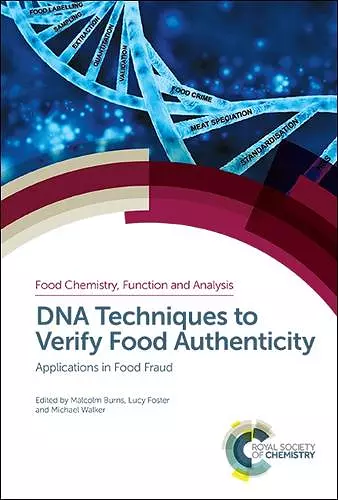DNA Techniques to Verify Food Authenticity
Applications in Food Fraud
Michael Walker editor Lucy Foster editor Malcolm Burns editor
Format:Hardback
Publisher:Royal Society of Chemistry
Published:16th Oct '19
Should be back in stock very soon

The food supply chain needs to reassure consumers and businesses about the safety and standards of food. Global estimates of the cost of food fraud to economies run into billions of dollars hence a huge surge in interest in food authenticity and means of detecting and preventing food fraud and food crime. Approaches targeting DNA markers have assumed a pre-eminence.
This book is the most comprehensive and timely collection of material from those working at the forefront of DNA techniques applied to food authenticity. Addressing the new field of analytical molecular biology as it combines the quality assurance rigour of analytical chemistry with DNA techniques, it introduces the science behind DNA as a target analyte, its extraction, amplification, detection and quantitation as applied to the detection of food fraud and food crime. Making the link with traditional forensic DNA profiling and describing emerging and cutting-edge techniques such as next generation sequencing, this book presents real-world case studies from a wide perspective including from analytical service providers, industry, enforcement agencies and academics. It will appeal to food testing laboratories worldwide, who are just starting to use these techniques and students of molecular biology, food science and food integrity. Food policy professionals and regulatory organisations who will be using these techniques to back up legislation and regulation will find the text invaluable. Those in the food industry in regulatory and technical roles will want to have this book on their desks.
This is an ambitious book. The scope ranges from the basic science and history of DNA testing to cutting‐edge techniques and case studies. It aims to be the go‐to reference for testing laboratories new to the DNA field, for people in food industry technical roles, for students and for regulators; it is likely to be a well‐thumbed fixture on their desk. The book achieves its aim of providing something for everyone, over a very wide target audience.Throughout the book, the underlying theme is consistently stressed: that the rigour traditionally applied to analytical quality control must equally be applied to DNA‐based methods.
* https://doi.org/10.1002/fsat.3401_16ISBN: 9781788011785
Dimensions: unknown
Weight: 706g
325 pages